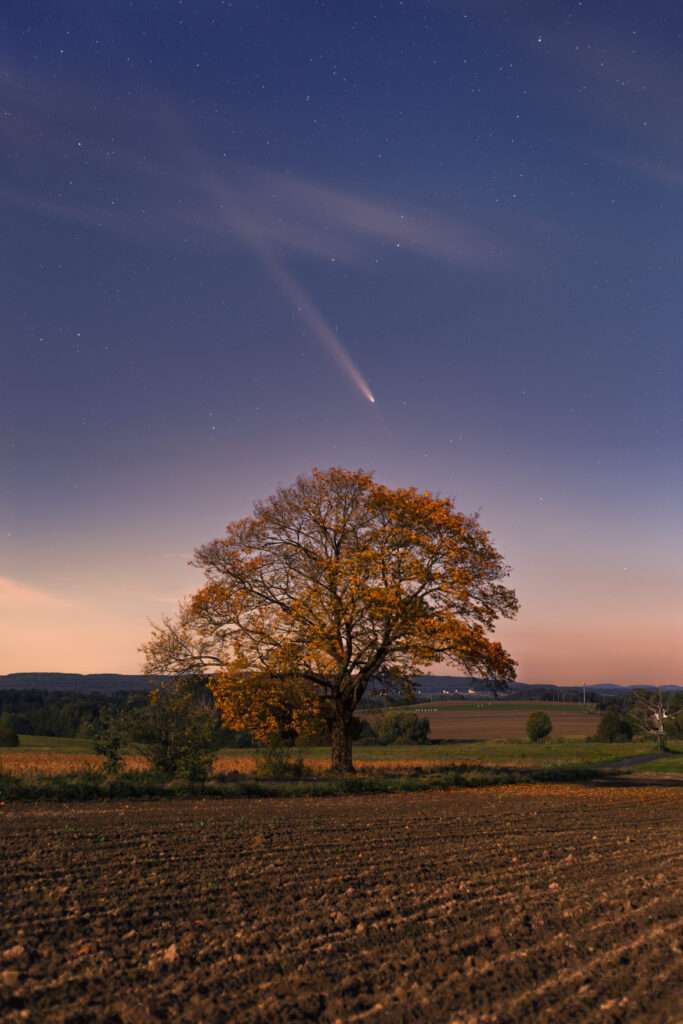Comets are fascinating objects that orbit the Sun, bringing with them cosmic footprints from distant parts of the Solar System. Sometimes even from regions of deep space. Each new comet is an opportunity for astronomers to observe and study material that is billions of years old and may contain clues to the formation of our Solar System and the Universe. One of the new additions among the known comets is the hairpin comet C/2023 A3 Tsuchinshan-ATLAS.
The comet was detected on February 22, 2023, during the Asteroid Terrestrial-impact Last Alert System (ATLAS) systematic sky survey, as a then still "asteriodal" object of magnitude 18.1. The image was taken by the 0.5 m diameter Schmidt Chamber mirror at Sutherland Observatory in South Africa. After initial orbital calculations, the object was identified with an 18.7 magnitude bright object observed by the Chinese Chuo-Linshan (Tsuchinshan) Observatory as early as January 9 of that year. Subsequently, the object was even found in earlier images taken as part of the Zwicky Transient Facility (ZTF) photographic sky survey at Palomar Observatory on December 22, 2022. At that time, it was even fainter, reaching magnitudes 19.2-19.6. Nevertheless, a condensed coma and a fine straight tail of 10 arcseconds were detected in these images. This confirmed the cometary nature of the object.
The comet is, or rather was, near our Sun for the first time, after gravitational forces from the Oort cloud at the edge of the Solar System steered it towards the Sun after billions of years of "quiet life". And the Sun's gravitational influence had the effect of sending it on a journey out of our system into the depths of interstellar space. Contrary to astronomers' original idea that it would return to us again after many tens of thousands of years.
The Oort Cloud is located at the very edge of the Solar System, even beyond the Kuiper Belt, where Pluto and other dwarf planets orbit. It is extremely rich in cometary nuclei, i.e. icy-dusty objects dating back to the early formation of our planetary system. Because it's so far away, comets take thousands to hundreds of thousands of years to reach the Sun, if they make the journey.
Our comet will pass through the ground on September 27, 2024, and through the ground on October 12, 2024, at a distance of 41.1 million kilometres from Earth. During October, it was also quite observable from the Czech Republic. Although the weather often spoiled our observations and its brightness decreased very quickly with time.
Author of this photo (cutout used as title photo, full photo is below - editor's note) Daniel Kurtin took advantage of the "almost" clear sky and the low position of the comet above the horizon to create an interesting autumn photographic composition. The comet's tail reaches almost 20° in this image, even in bright moonlight. Also (or perhaps especially) noteworthy is the beautifully rendered contrail pointing towards the Sun.
Even though the Czech Astrophotography of the Month competition received a large number of portraits of this hairless comet, this image impressed the jury not only with its own comet, but also with its pleasant autumn composition. We would like to thank the author and congratulate him on winning the October round of the competition.

Author Daniel Kurtin
Name: great comet C/2023 A3 Tsuchinshan-ATLAS in autumn colours
Place:Bulovka, Frýdlant region
Date: 16 October 2024
Sensor: Canon EOS 6D (modified)
Optics: Canon EF 50 mm f/1.8
Installation: none
Setup: 55×5 seconds, f/3.5, ISO 1600 (foreground one exposure), editing in Camera Raw, compositing in Sequator, final editing in Photoshop.
You can see the winning images in each month and more information at http://www.astro.cz/cam/.
On behalf of the ČAM jury Marcel Bělík, Úpice Observatory
(For)/ gnews - RoZ



